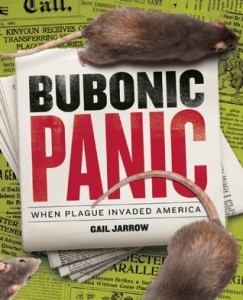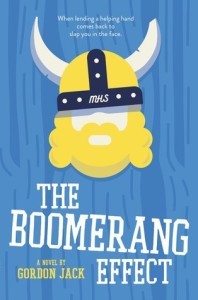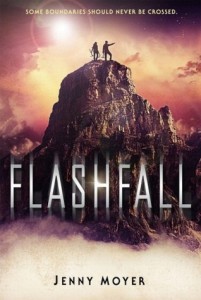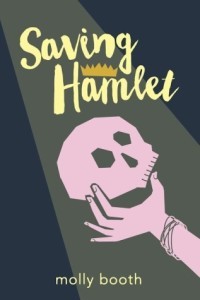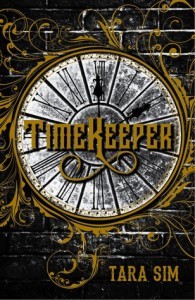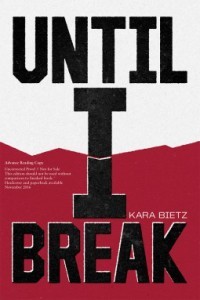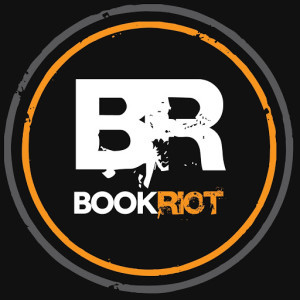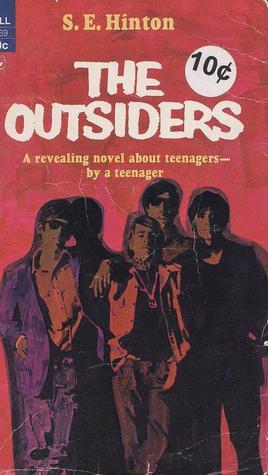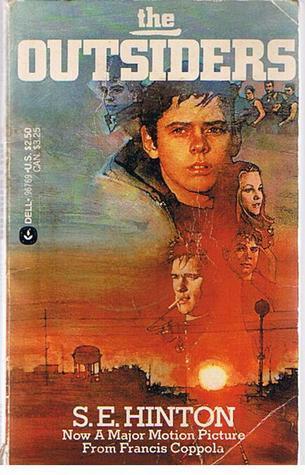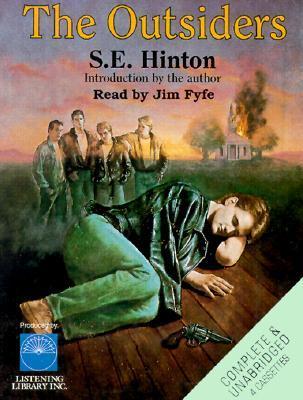Kelly Jensen's Blog, page 68
November 23, 2016
Preorder HERE WE ARE: FEMINISM FOR THE REAL WORLD & Snag a Bookmark
I’ve had a good number of people tell me that they wish Here We Are: Feminism For The Real World was available for the holidays, especially with the political climate as it is. They want to gift it to someone they love.
This makes me so happy and it also makes me sad that that’s not possible.
But can I offer an incentive?
I plan on having a big preorder giveaway at the turn of the new year, but I want to do something for those who are preordering already and/or are giving the book as a gift this season and want to give something physical to the recipient.
Enter: signed book marks.
I got a limited number of Here We Are bookmarks made for promotion, and it makes little sense for me to keep them for myself. So here’s the deal: preorder a copy of Here We Are: Feminism for the Real World for someone for the holidays (I don’t care if it’s for yourself!) and send a copy of the receipt/proof of preorder to kelly@stackedbooks.org. Along with that proof of purchase, send me your address, and I’ll send you a bookmark. If you want the bookmark signed or personalized, drop a note what you’d like it to say and/or who you’d like it made out to.
Because of costs, this offer is good for US and Canadian residents only, and it runs through December 12 (ensuring that you’ll get the bookmark for the holiday gift-giving season). I don’t believe I’ll run out of bookmarks for this giveaway, but if I do, I’ll update this post.
Whether you preorder now and snag a bookmark or preorder later, hang on to those proofs, as I will be doing another incentive like this in the new year. If you already preordered and want a bookmark, that’s fine, too!
Preorder from any of these links or your local bookstore. If you want to order from my indie bookstore, you can do that here.
November 20, 2016
Cybils Reviews: YA and Middle Grade Nonfiction About Science & Disease
Reading nonfiction for Cybils this year has been really enjoyable and it’s been really neat to not just see the range of topics covered, but it’s been neat to think about the connections between and among them. What do these connections say about the things we’re thinking about on a broader cultural level?
A number of the books have fallen into the broad category of science, and this is an area of nonfiction I love. But saying that books fall into a “broad category of science” doesn’t quite nail what these books have in common — rather, these books look at the side of science concerned with making our world a better, safer place for human and animal kind. They marry science and history in smart, accessible ways.
Here’s a look at a handful of those books, which tackle topics of disease, global warming, extinction, and and more.
This middle grade title explores the third “wave” of bubonic plague, which made its way to America in the early 1900s in San Francisco. Picking it up, I didn’t expect to take away as much as I did about the disease — this was a topic I wrote a lot about in high school and felt like I’d learned enough about and yet, this was an entire aspect of public health and history I didn’t know happened. I suspect a reason for this lack of knowledge might come from what Jarrow touches on (and ultimately doesn’t dig into as much as I wish): racism. Those most susceptible to America’s bubonic plague were Asian immigrants, and the choices politicians made to slow down the spread of the disease targeted Chinatown specifically.
The book isn’t entirely about the disease in America though, and it was fascinating to see the history of bubonic plague traced back into three distinct waves. It’s my suspicion most people, self included, are familiar with the second wave which hit Europe and less aware of the first and third waves. Jarrow does an excellent job telling the history of this disease not just through science and discovery, but she makes it into a mystery. She explores what caused the disease, why it happened in waves, and the roles scientists played in trying to figure out the reason behind the disease, who it targeted, and how to put an end to it. I found much of the discussion of trying to find an immunization for the disease to be some of the most interesting material in the book.
In terms of design, this is a visually appealing book. It’s full color, with thoughtful use of images and sidebars that highlight, rather than detract from, the greater text. I do wish there was a different trim size, since it’s one of those books that is odd to hold and read, but I also understand that to get the visuals to look great, that was likely a necessary choice.
The back matter is excellent, and I found the FAQs that Jarrow chose to include at the end of the book really thought-provoking. It was clear she anticipated some questions from young readers and she addresses them succinctly and smartly.
Fun fact: I knew the plague was still a thing in the American southwest; in mid 2007, my husband and I were driving from Las Vegas to Austin and stopped one night in a New Mexico town, where the lead story was about a small local outbreak. I was surprised, but learning about the fact that it’s rodents and fleas associated with them that can cause the illness makes that make more sense. Likewise, this book will likely heighten fear from the hypochondriacs out there, since this is a disease that’s still possible and Jarrow doesn’t ignore that.
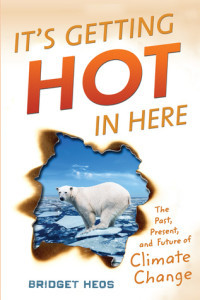 It’s Getting Hot In Here: The Past, Present, and Future of Climate Change by Bridget Heos
It’s Getting Hot In Here: The Past, Present, and Future of Climate Change by Bridget Heos
This YA nonfiction title is for those who love their science with numbers, figures, and graphs. It’s a well-argued book about the impact of climate change and the need to get serious about protecting our planet. Heos hedges her arguments very well — she clearly delineates the scientific evidence from the political aspects of the global warming argument and then further provides a point for readers to ponder over as she notes that GMOs are also in one of those personal/political/science gaps where science says GMOs are totally fine but individuals find a lot more to chew on with them than they do with things like global warming…also backed by science.
There are times this goes on too long and the middle gets a little boring. Readers who are really into sustainability and global warming will likely love this length, though. This is full-color throughout and the format is a traditional novel trim, making it read really well and look really great. It’s appealing on every level and the use of images and side bars to break up text was well thought out and added, rather than detracted from, the text.
Heos goes further to offer ways for individuals to do better with their impact on the Earth. These tips aren’t hard and don’t cost money, and Heos addresses both of those issues before providing the tips, too.
It’s smart how she sets up her arguments and defends them, and it’s done in a way that would make this an excellent read for those teens looking to learn how to craft an argument and support it well. There are discussions of both sides of the issue but the counter argument is picked apart because of science, numbers, and data. For the general reader, though, it might be overwhelming to sift through.
This is another read with good backmatter, so it will work not only as a solid nonfiction read for leisure, but it also serves as a great resource for those doing research or who want to dig even further into global warming.
I read this one a few weeks back, and even though it did drag for me, I find myself returning to some of the points Heos made. In early November, I sat on the beach, here in southern Wisconsin, and realized it was absurd and terrifying to be doing such a thing. The beach was packed, people were putting their feet in the water, and everyone carried on like it was a perfect summer evening. That was why I was there, and yet, I couldn’t stop thinking about how global warming was to thank for such a gift. . . if it could be considered a gift at all.
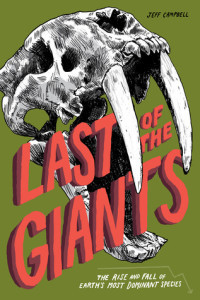 Last of the Giants: The Rise and Fall of Earth’s Most Dominant Species by Jeff Campbell, illustrated by Adam Grano
Last of the Giants: The Rise and Fall of Earth’s Most Dominant Species by Jeff Campbell, illustrated by Adam Grano
An engaging, at at times difficult, YA title to read about a number of “giant” species that have gone extinct in the last 500 years. Campbell explores the whys and hows of the extinctions, with some interesting — at times slightly judgmental — ways that humans have impacted these natural beasts. “Giant,” as Campebell explains early on in the text, not only refers to size, but it also refers to species like the passenger pigeon in the US which were abundant one day and then completely gone the next. As a reader, I found reading that section particularly difficult, as it highlighted the brutal ways humans interacted with nature.
Some of the most fascinating pieces of this book were the descriptions of islands that, while populated today, were once ecological wonders. Campbell describes an unbelievable world in New Zealand, where giant birds were abundant and wild; he also digs into the amazing ecoculture of Madagascar and how humans arriving in both islands invariably changed the natural habitats and livelihoods of many creates. Some we know the stories of and others we’ll never quite know.
The backmatter is great, and I turned to one of the videos referenced back there about the Tasmanian tiger and definitely got a little teary-eyed. I do wonder, though, if more of the backmatter could be better integrated into the text or into footnotes in instances like this, as it was not easy to flip back and find the video being referenced in text because there’s so much backmatter.
My biggest criticism, besides perhaps the book being a bit lengthy, is that the layout is bizarre. The pull quotes make no sense and take up way too much room in spaces where it was unnecessary. I’d have liked more sidebars and more “did you know” kind of things sprinkled throughout that would make the text a little more digestible — perhaps those could have been places where “check out these videos” or other round-ups to juicy backmatter could be highlighted in text.
This isn’t a book that can be read easily in one sitting for that reason, especially for those who get heated up about animal rights, climate change, or other similar natural issues. There were times I had to stop because it made me a little weepy. Likewise, this is a book that’s just a bit long, and readers will want to take their time to digest what they’re reading. Picking this book up prior to the Heos book in my reading pile made me appreciate both a little bit more, as it was impossible not to see how the things Heos talked about mirrored some of what Campbell talked about, especially in regards to the disappearance of some of Earth’s richest and most diverse ecosystems.
November 19, 2016
Kirkus Reviews on HERE WE ARE: FEMINISM FOR THE REAL WORLD
I’m beyond please and proud and thrilled to share the first trade review of Here We Are: Feminism for the Real World. This is from Kirkus:
I couldn’t be happier with this review or the star (the STAR!).
If you want to preorder Here We Are, you can do so through your preferred online retailer with these links. I’m also going to link to my local indie, which is Read Between the Lynes, if you’d like to order through them. I’ll be doing a panel event with them March 15; more details as they come together.
As important to me, though, as this incredible review and collection, is this from Angie Manfredi:
There is a lot of hope in the world, and it’s sometimes easy to forget the impact that can be made on young people. This tweet will be one of my favorites forever.
Thank you to everyone who has shared the excitement of Here We Are this week and in weeks prior. It’s exciting to see it falling into more and more hands.
November 15, 2016
As You Wish: Inconceivable Tales From the Making of the Princess Bride by Cary Elwes with Joe Layden
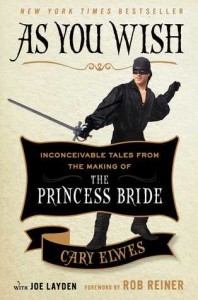 Do you need something happy and palate-cleansing to temporarily take your mind off the shithole that our country is descending into? Are you a fan of The Princess Bride? If your answer to both of those questions is yes, and I’m assuming it will be for most of our readers, allow me to recommend As You Wish, an excellent audiobook by Cary Elwes (with some help from Joe Layden) about the making of The Princess Bride, full of fun little stories and a huge heaping of love for everyone involved.
Do you need something happy and palate-cleansing to temporarily take your mind off the shithole that our country is descending into? Are you a fan of The Princess Bride? If your answer to both of those questions is yes, and I’m assuming it will be for most of our readers, allow me to recommend As You Wish, an excellent audiobook by Cary Elwes (with some help from Joe Layden) about the making of The Princess Bride, full of fun little stories and a huge heaping of love for everyone involved.
If you’re at all like me, it can be a bit of a bummer to learn that some of the actors or writers or creators involved in a piece of art you love actually hated each other. We want the actors to be as charming and kind as the characters they portray; we want their on-screen friendships to be mimicked behind the scenes. There’s nothing to fear about The Princess Bride in this regard – according to Elwes, Rob Reiner was the kindest of directors, Robin Wright was the most talented and beautiful of co-stars, and Andre the Giant’s stature matched his heart. In fact, everyone got along so well and the movie they made was so magical, many of them remember it as the best movie-making experience of their entire careers.
Elwes takes his listeners on a journey from the time he was cast as Westley to the movie’s release and the cast reunion 25 years later. Other actors and people involved voice their own parts as well, including Rob Reiner, William Goldman (referred to as Bill by Elwes), Robin Wright, Wallace Shawn, Billy Crystal (calling in by phone), Christopher Guest, and Chris Sarandon. Hearing this chorus of voices really does an excellent job of bringing the listener right back into the world of the movie, and I highly recommend you listen to this on audio because of it.
We learn that Elwes, on Andre the Giant’s urging, took Andre’s ATV out for an ill-advised spin and broke his toe, which is why you can see him limping a bit as he and Buttercup race into the Fire Swamp. There’s an amusing story about one of the stuntmen who portrayed a rodent of unusual size, and Wallace Shawn talks about his enduring fear that he could never measure up to Danny DeVito, whom the producers initially wanted for Vizzini (Reiner is quick to reassure us that Shawn was always the top pick and did a perfect job). Billy Crystal and Carol Kane’s improv skills are lauded, and Elwes talks about how difficult it was not to laugh while he was supposed to be mostly dead at Miracle Max’s. There’s nothing hugely revelatory in any of these little stories, and that’s kind of the point, I think. Everyone got along and they all remain friends. The film was a joy to make, and they produced something they’re proud of and that endures. Elwes portrays the film’s making as we all hoped it was: just like the film itself.
November 13, 2016
Debut YA Novels: November 2016
It’s time for another round-up of debut YA novels of the month. This round-up includes debut novels, where “debut” is in its purest definition. These are first-time books by first-time authors. I’m not including books by authors who are using or have used a pseudonym in the past or those who have written in other categories (adult, middle grade, etc.) in the past. Authors who have self-published are not included here either.
All descriptions are from WorldCat or Goodreads, unless otherwise noted. If I’m missing any debuts out in November from traditional publishers — and I should clarify that indie/small presses are okay — let me know in the comments.
As always, not all noted titles included here are necessarily endorsements for those titles. Since November is a bit of a slower month for publishing new voices, this might be a great month to catch up on titles that debuted earlier this year.
The Boomerang Effect by Gordon Jack
It all started with a harmless prank. But now high school junior (and resident stoner) Lawrence Barry is one step away from reform school unless he participates in a mentorship program. His mentee? Spencer Knudsen, a Norwegian exchange student with Spock-like intelligence but the social skills of the periodic table.
Then disaster strikes—Homecoming week. When someone dressed as the school Viking mascot starts destroying the fairy tale–inspired floats, all suspicion falls on Lawrence. Add to the mix a demon Goth girl named Zoe, a Renaissance LARPing group, an overzealous yearbook editor, and three vindictive chickens, and Lawrence soon realizes that his situation may be a little out of control. But Spencer seems to have some answers. In fact, Spencer may be the one friend Lawrence never knew he needed.
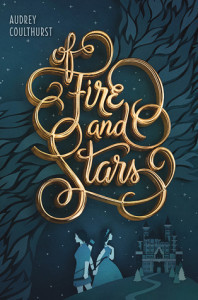 Of Fire and Stars by Audrey Coulthurst
Of Fire and Stars by Audrey Coulthurst
Betrothed since childhood to the prince of Mynaria, Princess Dennaleia has always known what her future holds. Her marriage will seal the alliance between Mynaria and her homeland, protecting her people from other hostile lands. But Denna has a secret. She possesses an Affinity for fire—a dangerous gift for the future queen of a kingdom where magic is forbidden.
Now, Denna must learn the ways of her new home while trying to hide her growing magic. To make matters worse, she must learn to ride Mynaria’s formidable warhorses before her coronation—and her teacher is the person who intimidates her most, the prickly and unconventional Princess Amaranthine (called Mare), sister of her betrothed.
When a shocking assassination leaves the kingdom reeling, Mare and Denna reluctantly join forces to search for the culprit. As the two work together, each discovers there’s more to the other than she thought. Mare is surprised by Denna’s intelligence and bravery, while Denna is drawn to Mare’s independent streak. Soon their friendship is threatening to blossom into something more.
But with dangerous conflict brewing that makes the alliance more important than ever, acting on their feelings could be deadly. Forced to choose between their duty and their hearts, Mare and Denna must find a way to save their kingdoms—and each other.
Flashfall by Jenny Moyer
Orion is a Subpar, expected to mine the tunnels of Outpost Five, near the deadly flash curtain. For generations, her people have chased cirium—the only element that can shield humanity from the curtain’s radioactive particles. She and her caving partner, Dram work the most treacherous tunnel, fighting past flash bats and tunnel gulls, in hopes of mining enough cirium to earn their way into the protected city.
But when newcomers arrive at Outpost Five, Orion uncovers disturbing revelations that make her question everything she thought she knew about life on both sides of the cirium shield. As conditions at the outpost grow increasingly dangerous, it’s up to Orion to forge a way past the flashfall, beyond all boundaries, beyond the world as she knows it.
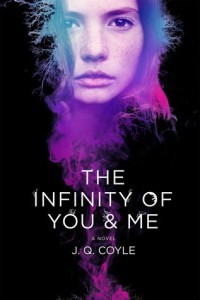 The Infinity of You and Me by J.Q. Coyle
The Infinity of You and Me by J.Q. Coyle
What if every life-altering choice you made could split your world into infinite worlds?
Almost fifteen, Alicia is smart and funny with a deep connection to the poet Sylvia Plath, but she’s ultimately failing at life. With a laundry list of diagnoses, she hallucinates different worlds—strange, decaying, otherworldly yet undeniably real worlds that are completely unlike her own with her single mom and one true friend. In one particularly vivid hallucination, Alicia is drawn to a boy her own age named Jax who’s trapped in a dying universe. Days later, her long-lost father shows up at her birthday party, telling her that the hallucinations aren’t hallucinations, but real worlds; she and Jax are bound by a strange past and intertwining present. This leads her on a journey to find out who she is while trying to save the people and worlds she loves. J.Q. Coyle’s The Infinity of You & Me is a wild ride through unruly hearts and vivid worlds guaranteed to captivate.
Emma Allen couldn’t be more excited to start her sophomore year. Not only is she the assistant stage manager for the drama club’s production of Hamlet, but her crush Brandon is directing, and she’s rocking a new haircut that’s sure to get his attention. But soon after school starts, everything goes haywire. Emma’s promoted to stage manager with zero experience, her best friend Lulu stops talking to her, and Josh–the adorable soccer boy who’s cast as the lead–turns out to be a disaster. It’s up to Emma to fix it all, but she has no clue where to start.
One night after rehearsal, Emma stays behind to think through her life’s latest crises and distractedly falls through the stage’s trap door . . . landing in the basement of the Globe Theater.
It’s London, 1601, and with her awesome new pixie cut, everyone thinks Emma’s a boy–even Will Shakespeare himself. With no clue how to get home, Emma gamely plays her role as backstage assistant to the original production of Hamlet, learning a thing or two about the theater, and meeting an incredibly hot actor named Alex who finds Emma as intriguing as she finds him. But once Emma starts traveling back and forth through time, things get really confusing. Which boy is the one for her? In which reality does she belong? Will Lulu ever forgive her? And can she possibly save two disastrous productions of Hamlet before time runs out?
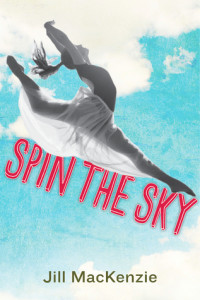 Spin The Sky by Jill MacKenzie
Spin The Sky by Jill MacKenzie
Magnolia Woodson wants nothing more than to get her and her sister, Rose, out of the pitifully small, clamming-obsessed Oregon town that hates them—she just doesn’t know how. Forced to put up with the snide comments and hateful looks the townspeople throw at them, Mags thinks she’s destined to pay for the horrible, awful thing her mom did—and that she’s left her and Rose to deal with—until the day she dies.
But when a nationwide televised dance competition posts tryouts in nearby Portland, Mags’s best friend, George, says they have to go and audition. Not only have they spent the past fourteen years of their lives dancing side-by-side, dreaming of a day just like this, but also it could be Mags’s chance of a lifetime—a chance to win the grand-prize money and get her and Rose out of Summerland, a chance to do the thing she loves most with everyone watching, a chance to show the town that she’s not—and has never been—a “no-good Woodson girl,” like her mother. But will the competition prove too steep? And will Mags be able to retain her friendship with George as they go head-to-head in tryouts? Mags will have to learn that following her dreams may mean changing her life forever.
Timekeeper by Tara Sim
In an alternate Victorian world controlled by clock towers, a damaged clock can fracture time—and a destroyed one can stop it completely.
It’s a truth that seventeen-year-old clock mechanic Danny Hart knows all too well; his father has been trapped in a Stopped town east of London for three years. Though Danny is a prodigy who can repair not only clockwork, but the very fabric of time, his fixation with staging a rescue is quickly becoming a concern to his superiors.
And so they assign him to Enfield, a town where the tower seems to be forever plagued with problems. Danny’s new apprentice both annoys and intrigues him, and though the boy is eager to work, he maintains a secretive distance. Danny soon discovers why: he is the tower’s clock spirit, a mythical being that oversees Enfield’s time. Though the boys are drawn together by their loneliness, Danny knows falling in love with a clock spirit is forbidden, and means risking everything he’s fought to achieve.
But when a series of bombings at nearby towers threaten to Stop more cities, Danny must race to prevent Enfield from becoming the next target or he’ll not only lose his father, but the boy he loves, forever.
Until I Break by Kara Bietz
Two boys: One, a star athlete and top student with a deep-seated need to prove himself. The other, a chip-on-his-shoulder quarterback who will never settle for second best. When gunshots echo through the halls of Broadmeadow High School, whose finger is on the trigger?
A year before the shooting, Sam North has a bright future as a well as a problem that nobody else seems to see—Ace Quinn, his neighbor and teammate. For years, Ace has been bullying and harassing Sam, yet he’s managed to deftly conceal his actions and threats from the rest of the world. As Ace’s secret rage intensifies, Sam becomes more desperate to stop him. But how far will he go? And what if Ace takes his threats even farther?
November 10, 2016
This Week at Book Riot
I wasn’t going to do my Book Riot link up this week because I’m still trying to wrap my head around the election results. But I’ve been reminded numerous times that talking about books, about reading, about teenagers, that those things are helpful, rather than hurtful right now.
First though, some reflections on what now.
3 On A YA Them looks at 3 recent YA books where there are water towers on the cover. Weird microtrend?
Where is the love for nonfiction for young readers? Why is it we don’t talk about or get excited about YA or middle grade nonfiction like we do fiction?
If you don’t already get the Book Riot “What’s Up in YA?” newsletter that I write, you might want to subscribe now. Monday’s piece is a guest writer and it was everything I needed to hear and see and think about. The newsletter is moving from biweekly to weekly, which means more YA talk in your inbox — and I’m committed to keeping it the best that it can be.
Thanks for being our readers. Pick up a good book or two this weekend, and press them into the hands of young readers. It matters.
If you’re at Book Riot Live, I hope you say hello to me this weekend. I’ll be there Saturday and Sunday all day. If you would like a Here We Are bookmark, too, ask and I’ll pass one your way.
Monthly Giving: Transforming Thought Into Action
I didn’t think I was going to write anything today. Mostly, I felt like I had no words to express what I was feeling in a way that would be relevant to our mission here at Stacked – how could I write about books today, and who would even care if I did?
But then I woke up this morning, with my grief a blanket around me, and my feelings of anger, despair, and hopelessness began to coalesce and transform into something else: a drive to do something useful. As a white woman, it’s been amply demonstrated that I, and others like me, did not do enough in the past weeks and months. For me at least, that ends today.
I have always felt like my job is part of the way I help further social justice. It was true when I was doing face to face public service, helping people find jobs and information and a friendly face, and it’s true now when I work behind the scenes, selecting books for kids. Every time I select a book that features a child of color, or a trans teenager, or a disabled person, or any other person whom our culture overwhelmingly says is of less value, I know that book is vital and could change a child’s life. Sometimes these actions feel small – it’s my job to do this, after all – but I have known too many librarians who think buying books that feature kids like these is tokenism or “PC” or a waste of money.
But my paid work is not enough, nor is championing diversity on the blog. Not anymore. So today I made the choice, as one of many more steps I will take, to contribute financially. Each month, I’ll select an organization to donate money to, and because I want my actions to reverberate as loudly as possible so as to inspire others to do the same, I’m posting about it on social media and I’m going to post about it here, too. Because I’m a librarian and I can’t help it, there will be a book list with each post. My sincerest hope is that our readers will choose to donate alongside me, particularly if you have the means and you don’t already contribute regularly to other groups. Even a small donation can help.
This month, I chose to donate to the Trans Lifeline, a non-profit run by transgender people for transgender people. In their own words: “Trans Lifeline volunteers are ready to respond to whatever support needs members of our community might have.” Trans people are some of the most vulnerable people in our country, and this is one way we can help. A $25 donation pays for one day of calls, and any number of those calls could improve – or save – people’s lives.
And here’s a list of recommended books about trans & gender-nonconforming kids and teens, perfect for a display. As always, check out the Stonewall Book Awards (the Mike Morgan and Larry Romans Award is for youth) and the Rainbow Book List for more worthy titles about trans kids and teens plus others who identify within the GLBTQ acronym.
FICTION
10,000 Dresses by Marcus Ewert
Jacob’s New Dress by Sarah and Ian Hoffman
Introducing Teddy by Jess Walton
George by Alex Gino (#ownvoices)
Gracefully Grayson by Ami Polonsky
The Other Boy by M. G. Hennessey
If I Was Your Girl by Meredith Russo (#ownvoices)
How Beautiful the Ordinary: Twelve Stories of Identity edited by Michael Cart (includes some #ownvoices)
Beautiful Music for Ugly Children by Kirstin Cronn-Mills
Happy Families by Tanita S. Davis
Parrotfish by Ellen Wittlinger
Almost Perfect by Brian Katcher
Beast by Brie Spangler
Luna by Julie Anne Peters
I Am J by Cris Beam
Jess, Chunk, and the Road Trip to Infinity by Kristin Elizabeth Clark
NONFICTION
I Am Jazz by Jazz Jennings and Jessica Herthel (#ownvoices)
Being Jazz: My Life as a Transgender Teen by Jazz Jennings (#ownvoices)
Rethinking Normal: A Memoir in Transition by Katie Rain Hill (#ownvoices)
Some Assembly Required: The Not-So-Secret Life of a Transgender Teen by Arin Andrews (#ownvoices)
This Book is Gay by James Dawson
Beyond Magenta: Transgender Teens Speak Out edited by Susan Kuklin (#ownvoices)
The Gender Quest Workbook: A Guide for Teens and Young Adults Exploring Gender Identity by Rylan Jay Testa
November 6, 2016
The Outsiders: Read & Blog Along
If you’re taking part in the read/blog along for The Outsiders, feel free to leave your posts or thoughts in the comments here and I’ll do a nice round-up at the end of the week.
____________________
I picked up Hinton’s classic — perhaps the first YA book to be designated as such in 1967 — having little idea of the story. Sure, I knew some of the classic lines, and I knew the character names, and I was also somewhat familiar with the themes in the story. But I had no idea how it progressed, what the writing would be like, nor what would stand out to me as a reader. Going in with a lack of preconceptions was great, and it reminded me why reading backlist can be so rewarding and enjoyable in a way that sometimes reading the newest, latest, most buzz-y books isn’t. You get to sink in slowly, at your own pace, for yourself, rather than be steeped.
There’s not a lot to say in terms of plot, though; this is a story about a group of boys known as the greasers (which, yes, every time it showed up on page, reminded me of Grease and John Travolta) and their rival group known as the socs (so-ches). The two groups are divided by the city they live in physically but more importantly, they’re divided economically. The greasers are your poor kids and the socs are your middle class kids. The hobby du jour in town is for the two groups to rumble. In a present-day story, rumble would not be the word. It might be something more like fisticuffs.
Ponyboy is the protagonist and he’s 14, living with his older brother Sodapop, who is a high school drop out and his even older brother Darry. Darry is in charge of the boys since both parents died in a car crash prior to the story beginning. It’s a rough life, and Ponyboy feels throughout the story that he wants to be like Sodapop, and he fears his older brother Darry doesn’t like him. We learn, though, that it’s simply the way that Darry worries about Ponyboy that causes him to be strict or, as Ponyboy sees it, mean and cold.
Hinton does a great job telling us about the living situation, and knowing that this book is written as a story in a story — spoiler alert, it’s what Ponyboy writes to earn extra credit in one of his classes — it’s forgivable there is more telling of the story than showing it. We don’t really see the difference in class other than hearing about it, but knowing it’s through the perspective of a younger teen boy, it’s not hard to buy by any stretch of the imagination. What works wonderful through this storytelling device more than anything, though, is the emotion. We get to know exactly what Ponyboy thinks and feels, since he’s removed enough from the story to tell it and reflect on it while he’s telling it. This serves to give us a real sense of fear, of anger, of sadness, and of motivation he has.
The Outsiders is infamous for being one of the first YA books that really showcased the YA voice and perspective in a way that makes clear grownups aren’t always aware of the challenges and hardships that comes during adolescence. We’re there in the rumbles and we’re there through the emotional ups and downs of having friends who are hurt, who make poor choices, and the sorts of consequences that occur with both. Because that’s the thing about adolescents, about teenagers: they make stupid choices. A perennial complaint from adult readers of YA is that the main characters do dumb things, but anyone who knows a thing about teenagers knows that that is part and parcel of being that age. You’re learning, making choices that don’t always make sense, and yet, those are the places where learning can occur.
So much of this is smartly mirrored in the adoration Ponyboy has for Sodapop. Soda, who he refers to by good looks and as if he “has it all,” isn’t particularly book smart, and he made the decision to drop out of high school. There’s not a value judgment placed upon it, but rather, it’s used as a means of highlighting to Ponyboy that, with his smarts and determination, he has the power to continue his education and go places with it. Sodapop doesn’t have those same opportunities open to him because of the choices he made. Where Ponyboy paints that picture of an idol, we also see as readers those pain points and those flashes of truth that Sodaboy is, too, a flawed character who has made and will continue to make some questionable choices.
From the beginning, I found myself most drawn to Darry as a character. I think a big reason for that is that he’s not described much from Ponyboy for a long time. We get this sense he’s quite removed, that because he’s the “adult” in the story, he doesn’t know the half of what’s taking place.
The thing is, though, Darry might be most conscious of everything going on and purposefully works to ensure that his brothers stay safe first and foremost. He’s the foil to Ponyboy and the rest of the crew in that he’s the “adult” that they are sure doesn’t “get” what it’s like to be constantly in danger or in regular fear of another battle with the socs.
The Outsiders is one of those books that it seems everyone reads in school. I remember that the regular Reading classes in 7th grade took this on. I was in an advanced Reading class, and we didn’t — I couldn’t tell you what we read, but I could tell you the other reading because it came with so much complaining from teens in that class. As a teen, I guess I sympathized (hard to say now, of course, but I suspect I did because assigned reading can be that way). But now as an adult, I see why it’s such a popular classroom staple. There are a million ways to talk about this book, its themes, its characters, its contributions to the larger canon of children’s lit, its perspectives on life as a teenager, and so on. There’s essentially no wrong way to read this book or dissect it because there’s so much juice to it.
And, perhaps a point worth digging into in more contemporary classrooms and discussions of the book, it’d be worth talking about whether it’s been dated or continues to hold an important place in literary history. I’d argue that it certainly does, as shades of Hinton’s classic run through so many other YA novels. But I’d also have to note that there are places that, were the novel to be rewritten today, would be suspect to more critical eyes and criticisms, and rightly so. The language used in the book isn’t particularly kind toward Natives (I flagged at least one passage about “screeching like an Indian”), which in and of itself would provide a lot of discussion and critical fodder. What would this book look like were it written today?
I’d venture to guess it wouldn’t need to change a lot. Even the lack of technology here doesn’t necessarily “date” the story; rather, written today, it might offer a better “show” of the difference in economic class between the greasers and the socs.
My biggest fascination with the book is a relatively small one: Ponyboy loves books and reading. We know that, but we not only know that because he’s telling the story; we know it because he shows us with what he’s reading and his knowledge of literature. The weaving in and use of Gone With The Wind is particularly memorable, if only because it gives the book a sense of humor. It’s wild to think of two tough boys choosing to read that book when they’ve run away from a crime, and it’s wild to think about it becoming such a powerful novel that defines their relationship as friends and what happens when one dies and the other lives.
If you haven’t, you should pick up Hinton’s The Outsiders. I wouldn’t put it on my list of favorites, but knowing the value of the novel canonically, as well as knowing how much influence it has had on YA over the last fifty years, it’s worth the few hours it takes to read the 200 pages. It’s a good starting point to YA for those who are new to the category, and it’s a great reference point for those wanting to expand their knowledge.
____________________
Whenever I take part in a read/blog along, I always love taking a peek at the covers for backlist titles. Here’s a selection of some good ones from over the years. It’s not comprehensive, and I left off the one that we’re probably all really familiar with in mass market.
Next year, in honor of the 50th anniversary of The Outsiders, there will be a special repackaged cover. It will look like this:
If I hadn’t already thought about Grease every time I read the word “greasers,” then this jacket might make me do it. I love how simple and powerful it is in its simplicity.
This is the cover I have for the 40th anniversary. It was part of the Penguin “Platinum” line, and it’s really sharp looking. The gray on the side line is slick. The only thing I don’t like is the choice to go with deckled edges on this one; for the life of me, I don’t get why that’s considered high end when it makes flipping through pages nearly impossible for the small handed like myself (not to mention how it makes quickly perusing for quotes impossible).
Another cover that came out in 2006 was the Classics line cover, and this might be among my favorites. It’s true to the feel of the novel — there’s mood with the color and lighting choices, as well as in the fact that the person on the cover is running away. But the “running away” is toward the reader, giving it even more pow.
This is the “official” 40th anniversary edition. It’s got a nice vibe to it, though it’s not all that memorable. It reminds me a lot of some of the covers I’ve seen for graphic novels (I assume that’s what the goal was here) and also, weirdly, a bit of Fahrenheit 451.
In 1971, you could snag this mass market edition for a mere 10 cents. I love that it looks like a bad, bad record cover. And those boys look like they might be too nicely dressed and polished to be greasers. Though they have the hair down. Is the guy in the middle wearing a chain?
This is about as perfectly 1982 as you could get in a book cover.
The 1988 audiobook from Listening Library gets so many points because it incorporates a pile of references from the book. The busy, cluttered feeling almost works with the color choices; the burning church is a real great addition. I wonder what a cover with just that as the central image might evoke in terms of readership.
November 1, 2016
The Diabolic by S. J. Kincaid
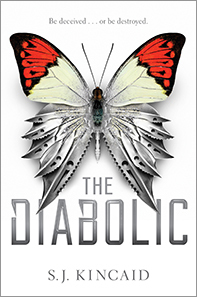 I first read this book in June, and I’ve been eagerly anticipating its release date (yesterday, November 1!) so I could publish this review. It was my favorite book of the year so far in June; it’s held its position since then. With The Diabolic, Kincaid has improved upon her Insignia series (which was quite good) and given us a true science fiction treat: a space adventure with a killer hook, complex world-building, political machinations that will interest teenagers, an unusual love story, characters you love and characters you love to hate, and a twisty plot that will leave you breathless. It’s got a bit of a Dune feel, a bit of a Game of Thrones feel, but it’s mainly its own thing, and it’s definitely written for teens.
I first read this book in June, and I’ve been eagerly anticipating its release date (yesterday, November 1!) so I could publish this review. It was my favorite book of the year so far in June; it’s held its position since then. With The Diabolic, Kincaid has improved upon her Insignia series (which was quite good) and given us a true science fiction treat: a space adventure with a killer hook, complex world-building, political machinations that will interest teenagers, an unusual love story, characters you love and characters you love to hate, and a twisty plot that will leave you breathless. It’s got a bit of a Dune feel, a bit of a Game of Thrones feel, but it’s mainly its own thing, and it’s definitely written for teens.
Nemesis is a Diabolic, a genetically engineered being created to protect Sidonia, a senator’s daughter. Nemesis is strong, ruthless, violent, and loyal to Sidonia only. Like all other Diabolics, she was forced to bond early on with the person she protects, and she is not considered to be fully human – or human at all, really. Years later, when Sidonia is a teenager, the Emperor orders all Diabolics destroyed; they are too dangerous. But Sidonia loves Nemesis, considers her a sister, a part of her family, so she is secretly spared. This comes in handy when Sidonia’s father, the senator, angers the Emperor and the Emperor calls for Sidonia to be a hostage at his court as a safeguard against future bad behavior. Because no one knows what Sidonia actually looks like, they decide to send Nemesis instead. After all, protecting Sidonia is what she was made for, and she does it willingly.
The story takes place against a backdrop of war between science and religion. Previous generations created the highly advanced ships and other advancements that their society now takes for granted, but the knowledge of their creation – and how to repair it all – has been lost over time. The ships are failing, and when they do, they’re killing people, and ripping holes in space. The Emperor’s family long ago imposed a religion that mandates no study of technology or science at all in response to this crisis, which is exactly the opposite tack Sidonia’s senator father and his allies think should be taken. Nemesis is caught in the middle of this, as the Emperor intended – or rather, he intended Sidonia to be. Watching Nemesis interact with the Emperor and his family members (who all have different motivations) is one of the joys of reading this book. Every line can have multiple interpretations, and Nemesis must puzzle out exactly what each character’s words and actions mean.
I’m a sucker for a well-plotted book, and Kincaid does a fantastic job with The Diabolic. Aside from the main plotline I described above, there are multiple ancillary characters who have intentions – good or ill – for Nemesis-as-Sidonia. Kincaid juggles multiple moving pieces with these characters, their behind the scenes doings, and how they connect (or don’t) to Nemesis’ situation as hostage. There’s also some nifty action scenes and several shocking twists (that make sense in context, so important!). The way everything plays out is so much fun to read. Meanwhile, Nemesis has to continue to convince everyone she’s the gentle senator’s daughter when she’s anything but (this book does get a bit violent at times, and Nemesis does kill to protect Sidonia), and acting in such a way causes her to wonder if she is in fact human. After all, Sidonia always believed she was. And there’s a really interesting romance, too, with a character you’ll guess right away, but it doesn’t develop as you think it will, and the two are actually drawn to each other due to commonalities in personality and goals, not just because they’re the two primary young people in the story.
I can’t really talk about the ending much, but I want to at least mention how much I love it. It’s a conclusive ending, but it also leaves an opening for Nemesis to change her mind, to further analyze the situation and the people around her and make changes based upon that analysis. The book ends here, and it’s a good ending, but Nemesis’ story goes on.
This should be a surefire hit with almost any teen science fiction fan. It’s a big story with tons of appeal factors: space travel, futuristic technology, an interesting new world, plot twists galore, a touch of romance, ruminations on the nature of humanity, and a kickass protagonist. Highly recommended.
October 30, 2016
Spooks, Scares, and Hauntings: A Horror Books & Reading Link Round-Up
Something I’ve been wanting to do more of is round-up links of interest for older posts we’ve written here at Stacked, as well as older posts you might be interested that Kimberly and I have written elsewhere. Being that we’re on year eight at STACKED, there are so many things we’ve touched upon and dug into, and much of it is perennially interesting.
In the spirit of Halloween — my favorite holiday! — I thought it’d be worth rounding up some of the backlist posts we’ve had here and elsewhere about horror, scary reads, and other spooky things.
Please note: when we changed blog hosting services last summer, some of our older posts got a little weird in their formatting. We’re working on updating those where possible. They’re entirely readable and usable; just sometimes, the images look funny or uneven.
A genre guide to all things YA horror and a handy genre guide to all things gothic fiction.
A round-up of YA horror reads that hit shelves in 2015.
On a similar note, here are some YA horror novels that hit shelves in 2014.
YA horror reboots and repacked covers.
Dracula‘s book covers through time. Similarly, this year on Book Riot, I showcased 40 awesome Frankenstein book covers.
YA and YA-appealing books about haunted houses.
A four-part “Horror 101” series from guest blogger Matthew Jackson can be read here, here, here, and here. Great for those just starting their journey into the world of horror, as well as those who love the genre and thinking about it even more.
Curious about the funeral business? Then these YA books will be up your alley.
Of course, we’ve talked about witches in YA fiction.
Horror talk and book lists we’ve shared elsewhere on the web:
Why YA horror is a staple and not a trend, which includes a big reading list and exploration of different themes within the genre, from School Library Journal.
At Book Riot, 65 great YA horror books written by women.
A crossword puzzle for YA zombie book fans.
What to read next for fans of Miss Peregrine’s Home for Peculiar Children.
I helped put together this handy reading guide for fans of horror movies that want to try a horror book with a similar feel to their favorite flicks.
Great YA books for those who love the show Stranger Things.
And a few fitting “3 On A YA Theme” posts of interest: girls who love horror movies, pee-your-pants scary reads, what to read if you love Supernatural, and books for those who can’t get enough Twin Peaks.


